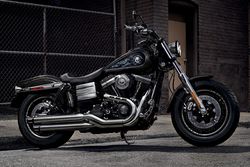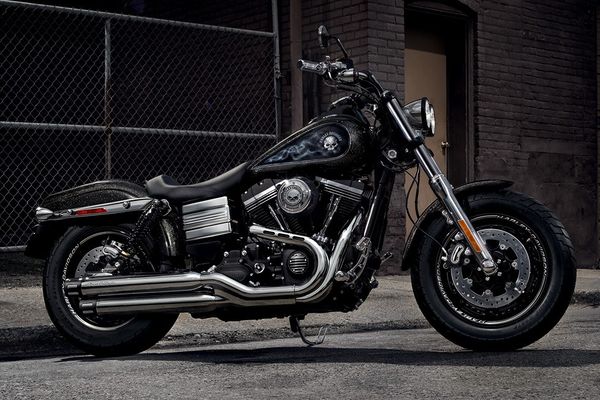Harley Davidson FAT BOB
 |
|
| Harley Davidson FAT BOB | |
| Manufacturer | |
|---|---|
| Production | 2017 |
| Class | Cruiser |
| Engine | Air-cooled, Twin Cam 103 |
| Bore / Stroke | 99.1mm x 99.1mm |
| Compression ratio | 9.7:1 |
| Torque | 95.89 ft/lbs (130.0 Nm) @ 3500RPM |
| Fuel System | Electronic Sequential Port Fuel Injection (ESPFI) |
| Transmission | Gear box: Gears Final Drive: Chain |
| Suspension | Front: Telescopic fork Rear: Dual shock |
| Brakes | Front: 4-piston fixed Rear: 2-piston torque-free floating |
| Front Tire | 130/90B16 67H |
| Rear Tire | 180/70B16 77H |
| Wheelbase | 63.82 inches (1621 mm) |
| Length | 94.49 inches (2400 mm) |
| Seat Height | 27.8 inches (706 mm) |
| Weight | 320.0 kg (wet) |
| Fuel Capacity | 1.32 Gallon (5.00 Liters) |
| Manuals | Service Manual |
The Harley Davidson FAT BOB was a Air-cooled, Twin Cam 103 Cruiser motorcycle produced by Harley Davidson in 2017. Max torque was 95.89 ft/lbs (130.0 Nm) @ 3500 RPM.
Engine
A 99.1mm bore x 99.1mm stroke result in a displacement of just 1690.0 cubic centimeters.
Drive
The bike has a Gears transmission. Power was moderated via the Wet Multi-disc.
Chassis
It came with a 130/90B16 67H front tire and a 180/70B16 77H rear tire. Stopping was achieved via 4-piston fixed in the front and a 2-piston torque-free floating in the rear. The front suspension was a Telescopic fork while the rear was equipped with a Dual shock. The FAT BOB was fitted with a 1.32 Gallon (5.00 Liters) fuel tank. The wheelbase was 63.82 inches (1621 mm) long.
2017 Harley Davidson FAT BOB
The beauty of the Milwaukee-Eight engine is that the Harley-cognizanti will be able to immediately tell that the Street Glide has the new 107 engine, while, to people with a more limited knowledge of the bike, will immediately know it is a Harley. The M-E takes the classic lines of the Twin Cam engine and makes them simultaneously more muscular and slimmer. While the Motor Company’s engineers say that the primary focus of the engine shapes was weight reduction (to allow for the increased weight of the new components in the engine), they also focused on maintaining and updating the Big-Twin’s iconic style.
